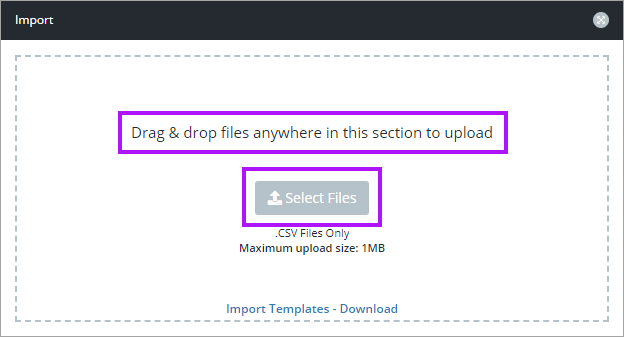Importing Passwords by CSV
If you encounter an error when importing please try opening your CSV in notepad++ and check to see if there are any extra columns on the csv.
If you wish to import a particular password into your My Vault, navigate to the My Vault section and select the Quick Add + New button and then select Import to Vault from the drop-down. There is also a specific Vault Import Template available here.
- The downloaded files are CSV files and can be opened in any spreadsheet editor.
- To import passwords, use the Passwords Import Template.
- On each row input a different password entry.
Populating the CSVs for Import
All characters must match exactly.
The Passportal ID field is always blank. Typing in an existing passwords ID will cause the import template to create a new entry.
The Client Name is the client that the password is being imported into. Multiple clients can be imported into using a single CSV file.
The Credential Type is the type of password and corresponds to the types listed on the Credential Types page. Examples include Router, Domain Administrator or Website.
Entering a Credential Type that does not currently exist in the Credential Types list will create that credential type. Like all other fields, this is case sensitive. Entering router will create that type, even if Router already exists. For more details, see Managing Credential Types.
The Description Field is displayed on any password list, ensure that it accurately describes the password.
Expires (Yes/No) is a toggle to determine whether the password will follow a rotation policy or not. Like all other fields this is case sensitive e.g. type Yes or No and not yes or no (lowercase).
The Notes section is for any additional information to be included with the password, including but not limited to; additional credential information, serial numbers, login instructions, alternate URLs, configuration information, etc.
The URL will store the URL for the password, and allow the website to be launched when viewing the password. This URL will also be used for our one-click login tools.
The Folder field will determine which folder the password will be imported into (if any) within the defined client. If the folder does not currently exist, it will be created. To add a subfolder add double forward slashes [ // ]. Admin//Firewall will create the folder Admin and the subfolder Firewall.
Like all other fields this field is case sensitive and for example, entering Tools in one password and tools in another password will create folders with matching names (one with an upprcase 'T' at start, and one all in lowercase).
When you are finished, ensure that all characters match exactly. The import is Blank space and case sensitive, improper white space and casings may cause undesired behavior.
If you have Carriage Returns within your notes, you will encounter issues performing the import. Following the Steps below will allow there to be Soft Carriage Returns which are allowed within the import.
- Select all cells where you want to remove or replace carriage returns.
- Press Ctrl+H to open the Find & Replace dialog box.
- In the Find What field enter Ctrl+J. It will look empty, but you will see a tiny dot.
- In the Replace With field, Press Alt+Enter. It will look empty, however, when you click Replace All you will see that changes have been made.
Performing the Import
- Navigate to Settings > Import / Export in the main menu.
- Drag-and-drop your CSV into the Import section or click the Select Files button and choose the file to be imported.
- If the file is correctly populated and has the .csv extension, it will show a list of the passwords that are to be imported.
- Review the data to be imported, then select Import.
- Once the import has completed, check the Import Status column for successful import status.
- The imported items will now be available in the locations configured in the .csv imported.
Where imported items do not appear in expected locations, review the import .CSV details to ensure correct data has been entered. Where the .CSV does contain correct data and import result is not as expected, please raise a support case.




